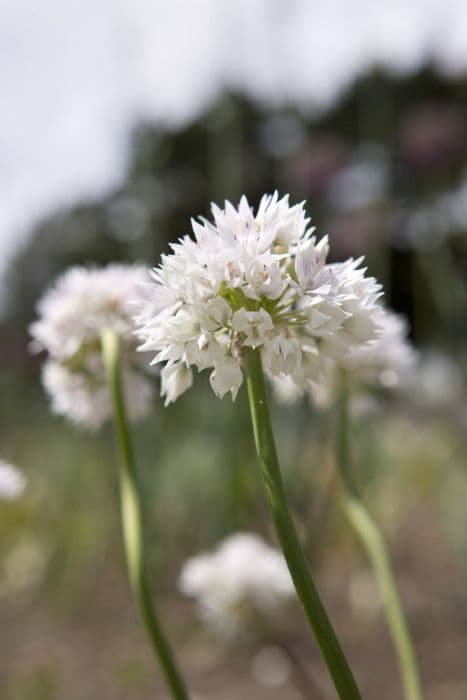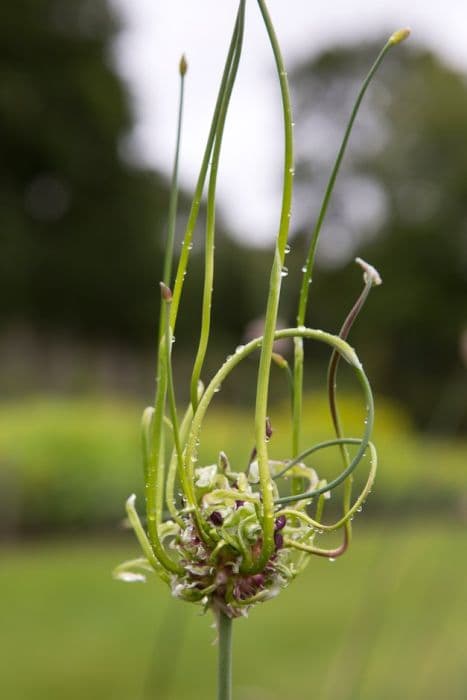Black garlic Allium nigrum

ABOUT
A. nigrum is a hardy perennial bulb, up to 75cm tall, with grey-green foliage. Large, open, creamy-white flowers, with a central greenish-black ovary, form rounded clusters with a flattened top, up to 10cm across, in early summer
About this plant
 Names
NamesFamily
Amaryllidaceae
Synonyms
Broadleaf Wild Leek, Black Garlic, Black Onion
Common names
Allium multibulbosum, Allium paucibulbosum, Allium magicum, Allium nigrum var. multibulbosum, Allium nigrum var. paucibulbosum
 Characteristics
CharacteristicsLife cycle
Perennials
Foliage type
Deciduous
Color of leaves
Green
Flower color
White
Height
2 feet [60 cm]
Spread
1 foot [30 cm]
Plant type
Bulb
Hardiness zones
4
Native area
Mediterranean
Benefits
 General Benefits
General Benefits- Edible Parts: Allium nigrum, commonly known as black garlic, features parts like bulbs and leaves that can be used in cooking for flavoring purposes.
- Culinary Uses: The bulbs of black garlic have a milder taste than many other garlic varieties and are used in a variety of dishes to enhance flavor without overpowering other ingredients.
- Ornamental Value: With its striking white flowers and lush green foliage, black garlic adds aesthetic appeal to gardens and landscapes.
- Wildlife Attraction: The flowers of black garlic can attract pollinators like bees and butterflies, aiding in the pollination of gardens and natural areas.
- Companion Planting: Black garlic can be used in companion planting to help deter pests from more sensitive plants in the vegetable garden.
- Soil Improvement: Like other members of the Allium family, black garlic can help improve soil quality by breaking up compacted soil with its deep roots.
 Medical Properties
Medical PropertiesThis plant is not used for medical purposes.
 Air-purifying Qualities
Air-purifying QualitiesThis plant is not specifically known for air purifying qualities.
 Other Uses
Other Uses- Culinary Decoration: The dramatic white blooms of the Black garlic can be used as an ornate garnish for gourmet dishes, elevating the visual appeal of the culinary presentation.
- Dye Production: The plant has potential as a natural dye source for fabrics, imparting a subtle color derived from its flowers or leaves.
- Photography Subjects: Enthusiasts of botanical photography may utilize the striking flowers of the Black garlic as subjects for their photographs due to their unique aesthetic.
- Garden Pest Deterrent: The strong scent of Black garlic may repel certain garden pests, making it a practical companion plant in vegetable gardens or ornamental borders.
- Floral Arrangements: Due to its attractive flower clusters, Black garlic can be incorporated into floral arrangements for a touch of elegance and height.
- Educational Tool: The plant can be featured in educational settings, such as botanical gardens or conservation projects, to demonstrate biodiversity and the variety of bulbous flowering plants.
- Wildlife Attraction: The flowers of Black garlic can attract pollinators such as bees and butterflies, contributing to the ecological health of a garden.
- Craft Projects: Dried flowers of the Black garlic can be used in various craft projects, including potpourri mixtures or decorative wreaths.
- Scented Gardens: Black garlic can be included in a scented garden design to provide a unique olfactory experience due to the distinctive smell of its blooms.
- Cultural Symbol: In some traditions, the Black garlic can symbolize good fortune or be used in ritualistic and ceremonial contexts due to its distinct appearance.
Interesting Facts
 Feng Shui
Feng ShuiThe Black Garlic is not used in Feng Shui practice.
 Zodiac Sign Compitability
Zodiac Sign CompitabilityThe Black Garlic is not used in astrology practice.
 Plant Symbolism
Plant Symbolism- Unity: Like other members of the allium family, Black Garlic symbolizes unity because of its spherical cluster of flowers which represent coming together.
- Good Fortune: Black Garlic is often associated with luck and prosperity, potentially rooted in its lush and full appearance.
- Protection: Traditionally, alliums like Black Garlic have been thought to ward off evil spirits and bad luck, making them symbolic of protection.
- Strength: The hardiness of Black Garlic, which allows it to thrive in diverse conditions, symbolizes resilience and strength.
- Healing: Known for its medicinal properties, Black Garlic can represent healing and the restoration of health.
 Water
WaterFor the Black Garlic (Allium nigrum), watering should be done deeply to encourage strong root growth, about once a week, ensuring at least one inch of water is delivered. During the growing season, especially in dry spells, maintain consistent watering, possibly increasing to twice a week. Be cautious not to overwater, as this plant prefers well-drained soil and can be prone to rot in overly moist conditions. In general, supply the Black Garlic with around 0.5 gallons per plant per week, adjusting as necessary due to rainfall or high temperatures.
 Light
LightThe Black Garlic (Allium nigrum) thrives best in full sun conditions, which means it should receive at least 6 to 8 hours of direct sunlight each day. Planting it in a location where it gets unobstructed sunlight will ensure optimum growth and flower production. Partial shade is tolerable, but full sun is ideal for this plant.
 Temperature
TemperatureThe Black Garlic (Allium nigrum) performs well in a temperature range between 50°F and 75°F, which are generally the temperatures experienced in spring through early summer when the plant is actively growing. This plant can survive brief periods of cold down to about 20°F but prefers not to be exposed to prolonged freezing temperatures. The ideal temperature range for growth and flowering is between 55°F and 65°F.
 Pruning
PruningBlack Garlic (Allium nigrum) requires minimal pruning, mainly to remove spent flower stems after blooming to maintain a tidy appearance and prevent self-seeding, if not desired. Pruning can be conducted right after the flowers fade in late spring or early summer. There's no need for regular pruning except for aesthetic purposes or to remove damaged or diseased foliage.
 Cleaning
CleaningNot needed
 Soil
SoilBlack Garlic requires well-draining soil that's rich in organic matter. A mix of garden soil, compost, and gritty material like perlite or sand is ideal. Maintain a soil pH between 6.0 and 7.0 for optimal growth.
 Repotting
RepottingBlack Garlic bulbs should be planted or divided every 3-4 years to ensure vigorous growth and prevent overcrowding. Repotting is usually done in the fall after the leaves die back.
 Humidity & Misting
Humidity & MistingBlack Garlic prefers average outdoor humidity conditions. It does not require unusually high humidity levels and thrives well in the natural fluctuation of outdoor environments.
 Suitable locations
Suitable locationsIndoor
Place in bright spot, water sparingly, let soil dry out.
Outdoor
Full sun to partial shade, in fertile, well-drained soil.
Hardiness zone
4-9 USDA
 Life cycle
Life cycleAllium nigrum, commonly known as black garlic, begins its life cycle when a seed germinates in fertile, well-drained soil. After germination, the seedling emerges and develops into a young plant with narrow, green leaves, characteristic of the Allium genus. As the plant matures, it forms a bulb beneath the soil surface, which stores energy for the following growing season. The plant then produces a tall stem, culminating in an umbel of star-shaped white to pinkish flowers, attracting pollinators for sexual reproduction. After pollination and flowering, seeds are formed and dispersed, while the foliage dies back, and the bulb enters a dormant period to survive adverse conditions. In the subsequent growing season, the bulb can either sprout new foliage to restart the cycle or produce offsets, leading to the growth of new plants.
 Propogation
PropogationPropogation time
Spring
The most popular method of propagation for Allium nigrum, commonly known as black garlic, is through division of bulbs. Typically, the best time to propagate black garlic by bulb division is in the fall after the foliage has died back. The process involves gently digging up the bulbs and separating them into individual cloves, taking care not to damage the base where the roots form. Each clove can then be planted immediately in well-drained soil, ideally with the base about 2 to 3 inches (5 to 7.5 centimeters) deep to accommodate root growth and ensure stability. Spacing between the cloves should be about 6 inches (15 centimeters) apart to allow for adequate air circulation and growth. Water the newly planted cloves moderately to encourage root development. With proper care, these cloves will develop into new plants and can be expected to produce flowers the following season.








